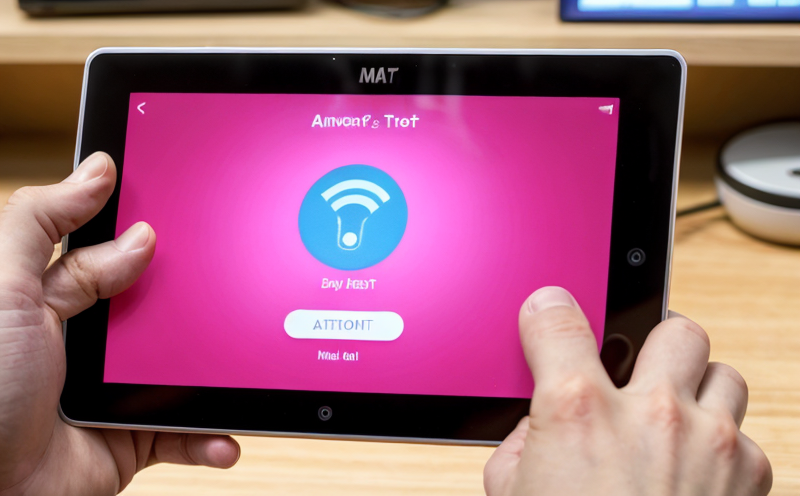Bluetooth Functionality Testing in Smart Devices
In today's interconnected world, Bluetooth technology is a cornerstone of smart and connected consumer devices. This technology enables seamless connectivity between various electronic devices, enhancing user experience across sectors such as healthcare, automotive, home automation, and more. For manufacturers, ensuring the robustness and reliability of Bluetooth functionality in their products is paramount to maintaining customer satisfaction and compliance with international standards.
Bluetooth testing encompasses a range of parameters that are critical for product performance. These include connection stability, data transfer speed, power consumption under different conditions, and interference resistance. Proper testing not only ensures that devices function correctly but also helps identify potential issues early in the development process, reducing costs and time-to-market.
The demand for smart devices continues to grow, driven by technological advancements and consumer expectations. As a result, rigorous Bluetooth functionality testing is essential to meet these demands while ensuring high-quality products that are compliant with relevant standards such as ISO/IEC 17025, ASTM E691-18, EN 340:2015, and IEC 62566. This service equips manufacturers with the necessary tools to meet these challenges head-on.
Our testing methodology involves a comprehensive approach that includes initial device setup, connectivity tests under various conditions (e.g., signal strength, background noise), data integrity checks, power consumption analysis, and interference resistance evaluation. Each test is conducted in controlled environments to simulate real-world usage scenarios, ensuring accurate results.
Understanding the importance of Bluetooth functionality testing extends beyond mere compliance—it also enhances product safety and user experience. By identifying and addressing potential issues early on, we help manufacturers develop products that are not only reliable but also meet or exceed customer expectations.
The process begins with a detailed review of the device specifications and expected functionalities. This is followed by initial setup and configuration of the test environment, ensuring all devices are properly connected and synchronized. Subsequent tests focus on connection stability, data transfer rates, power consumption, and interference resistance. Each test is meticulously recorded and analyzed to ensure comprehensive coverage.
| Application | Description |
|---|---|
| Wearable Devices | Testing Bluetooth functionality in wearable devices ensures seamless connectivity with smartphones and other accessories, enhancing user experience. |
| Home Automation Systems | Ensuring reliable Bluetooth connections within smart home systems allows for efficient control of various appliances and sensors. |
| Medical Devices | Robust testing ensures that medical devices maintain consistent connectivity, crucial for patient safety and effective treatment. |
| Automotive Electronics | Bluetooth functionality in automotive systems supports hands-free calling and entertainment features, enhancing driver safety. |
Why It Matters
Consumer electronics have become an integral part of daily life. The seamless interaction between different devices is made possible by Bluetooth technology, which allows for instant and secure connections. However, the complexity of smart devices means that even minor issues in Bluetooth functionality can lead to significant problems.
The importance of Bluetooth testing cannot be overstated. It ensures that products meet stringent quality standards set forth by international organizations. Compliance with these standards is crucial not only for regulatory reasons but also for maintaining a positive brand reputation and customer trust. Non-compliance can result in product recalls, financial losses, and damage to the manufacturer's image.
- Reduces the risk of product failures
- Ensures compliance with international standards
- Enhances user experience by providing reliable connectivity
- Maintains brand reputation through consistent performance
In addition to these benefits, rigorous testing also helps in identifying and addressing potential issues early in the development process. This proactive approach minimizes the need for costly post-production fixes, ultimately leading to a more efficient product lifecycle.
Scope and Methodology
The scope of Bluetooth functionality testing is broad and encompasses various aspects of device performance. The methodology we employ ensures comprehensive coverage of these parameters. Our approach starts with an initial assessment of the devices, followed by a series of tests designed to evaluate different facets of Bluetooth performance.
Key areas tested include connection stability, data transfer rates, power consumption under varying conditions, and interference resistance. Each test is conducted in controlled environments that simulate real-world usage scenarios, ensuring accurate and reliable results. The testing process is meticulously documented, allowing for detailed analysis and reporting.
To begin the testing process, we first review the device specifications and expected functionalities. This step ensures a thorough understanding of what needs to be tested. Next, initial setup and configuration of the test environment are carried out, ensuring all devices are properly connected and synchronized.
Subsequent tests focus on connection stability, data transfer rates, power consumption, and interference resistance. Each test is conducted under controlled conditions to ensure accurate results. Data from these tests is meticulously recorded and analyzed, providing a comprehensive overview of device performance.





